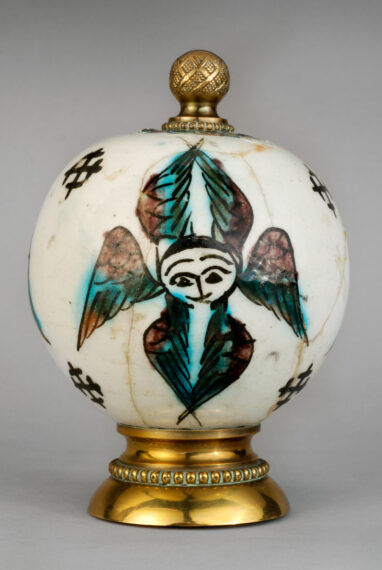H 101mm / D 70mm
Ceramic mounted on a base, decorated with three seraphim and six crosses. Note the particular colour of the seraphim’s wings, which are predominantly blue and brown.
The term “ceramics” refers to all the porous pastes obtained from a mixture of clay, sand and calcareous marl. This paste is covered after the first firing with a glaze: dipped into a tin-based enamel bath, called stanniferous enamel. This coating ensures that the items in earthenware, porcelain or terracotta are strong and solid, and more waterproof. Tin, which is colourless, gives the enamel its white colour upon firing.
Among the various kinds of earthenware that exist, the following are of particular interest
— Limestone earthenware, used for making decorative items;
— Fine earthenware, composed of white, fine clay. It is covered with a transparent varnish;
— Grand feu earthenware: the decoration and the enamel are fired at the same time. This involves a delicate manufacturing technique.
— Low-fire earthenware: The decoration is painted onto the fired enamel.
Armenian craftsmen were great innovators in the manufacture of earthenware in Kutahya, a village in the centre of present-day Turkey.
Inscriptions in Armenian characters, the use of the items manufactured, iconography, and historical and literary sources testify to the prominence of Armenian craftsmen in Christian and secular production at this great centre located in the heart of Anatolia.
Kutahya excelled in the manufacture of fine white ceramics, with polychrome decoration which was sometimes moulded. The dominant colours used were blue, bright yellow, bright green, sometimes manganese brown, and the brick red of the iconic Armenian ""bowl"", applied thickly to enhance or provide detail in a design. The oldest kind is decorated in blue and white. The shapes are very varied, with items intended for domestic use (cups, saucers, mugs, plates, teapots, ewers, flasks, rose water sprinklers), religious use (church balls, ornamental pieces), or decorative or dedicatory use (covering tiles).
There are also many kinds of decoration, including figurative, religious, plant motifs, and figures.
Many items bear the potter's mark on their base or under the lid. Some have a dedicatory inscription in Armenian characters and often with the date.
The compositions are highly original: the ornamental motifs consist of medallions, small patterns dotted over an area, garlands, chevrons, circular motifs, dots or scales, but it is rare for them to be repeated, there is no decoration stereotype and more emphasis is placed on spontaneity than order.
Frédéric Fringhian
Seraphim are winged hybrid beings with both human and animal characteristics. They are used to carry or guard the throne of the divinity. They perform important liturgical functions and act as intercessors in the hierarchy of angels. They have six wings: two to hide their eyes so as not to see God, two to hide their body and two for flying.
Kütahya, a city of 200,000 inhabitants, located at 930m above sea level in the hills of western Anatolia, 300km southeast of Istanbul. It is still home to many ceramic workshops that have forged its reputation since the 16th century.
